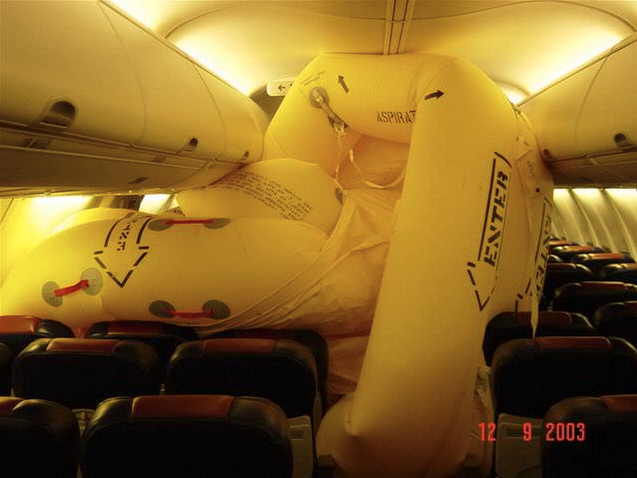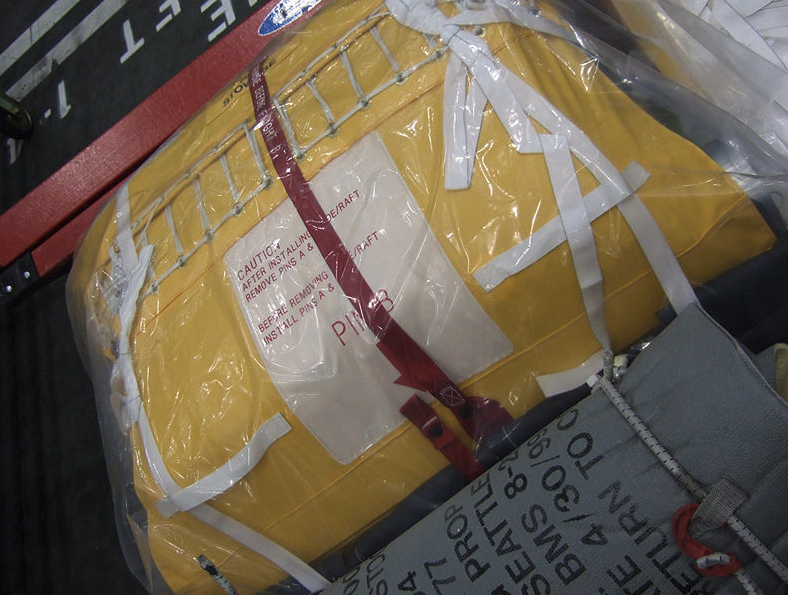If you fly a lot, chances are you’ve seen a lot of what happens on planes. You’ve probably learned quite a few things along the way, too. So maybe you already know:
- Why we board and disembark commercial plans on the left side
- The airline codes you’re not supposed to know about
- The less familiar reasons why you may be ineligible to sit in the exit row
And if you’ve been flying for long enough, you may even remember these 9 things you just don’t see at airports anymore.
However if you’re lucky, chances are you’ve never seen the deployment of an evacuation slide. I say “if you’re lucky” because the only time you should see the slide deployed is if there’s some sort of emergency. Well, or if you were on that Delta flight where a couple and their dog exited the plane during takeoff. OK, OK…or if this happened:

Whoopsie! (PC: No idea. Just saw it on the internet forever ago)
So yeah…evacuation slides. They’re inflatable slides held within the door structure of the plane. That way when the emergency exit is opened and the slides are deployed (read: filled with air), passengers can exit the plane and slide down them.

Undeployed evacuation side. PC: Public Domain
The first aircraft slide was patented by James F. Boyle in the mid-1950s. He’s the same guy who invented the World War 2 life vest. In the early days, the slides were canvas and the crew had to go through a whole procedure to get them set up. By the mid-1960s, inflatable slides were integrated with rafts.
In modern times, the FAA requires slides on all aircraft doors where the floor is 6 feet (1.8 m) or more above the ground. All large commercial aircraft have escape slides on the main doors but some also have slides for exits over the wings.
How they inflate
Smithsonian Magazine did a fantastic write up of how aircraft slides work. They explained it far better that I ever could.
What they look like when inflating
We’ve all seen pictures of fully deployed evacuation slides. But videos of them, on a variety of planes, bring it all up to a whole different level. These are all videos from controlled situations, such as maintenance checks. Take a look:
Boeing 747-400
Airbus A320
McDonnell Douglas MD11
Boeing 757
Airbus A380
Boeing 777-300
Feature Photo (cropped): Heide Couche, Air Force / US Dept. of Defense
Air Force Capt. Drew Pagenkopf, left, tactics flight commander, and Capt. Jose Hinojosa, right, C-5 evaluator aircraft commander, both with the 22nd Airlift Squadron, watch as Air Force Staff Sgt. Kevin Robinson, 22nd Airlift Squadron loadmaster evaluator, uses a C-5M Super Galaxy emergency escape slide at Travis Air Force Base, Calif., Sept. 6, 2019.
Want to comment on this post? Great! Read this first to help ensure it gets approved.
Want to sponsor a post, write something for Your Mileage May Vary, or put ads on our site? Click here for more info.
Like this post? Please share it! We have plenty more just like it and would love it if you decided to hang around and sign up to get emailed notifications of when we post.
Whether you’ve read our articles before or this is the first time you’re stopping by, we’re really glad you’re here and hope you come back to visit again!
This post first appeared on Your Mileage May Vary

1 comment
Similar to the auto-pilot deploying in the movie “Airplane.”